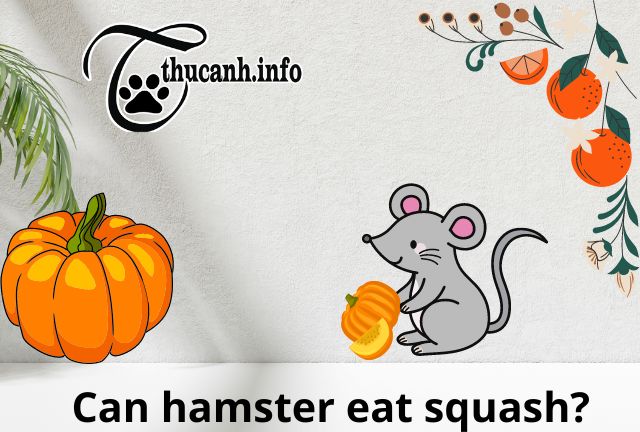Can hamster eat squash? Curious if hamsters can enjoy the deliciousness of squash? Discover the truth about feeding squash to your furry friend. Learn about the nutritional benefits, potential risks, and recommended portion sizes for hamsters.
Find out if squash is a safe and healthy addition to their diet. Don’t miss this informative guide on can hamsters eat squash.

Hamsters and Squash: Safe and Nutritious Delight
1. Can hamster eat squash?
Squash, a beloved vegetable in many households, is often questioned in terms of its suitability for hamsters.
Here is the quick answer to the question, Can hamsters eat squash? Yes, Hamsters can eat squash which consists of fiber, Vitamin A, Vitamin C, and a variety of minerals.
Note: Warnings when Feeding Hamsters Squash
While squash can be a healthy addition to your hamster’s diet, there are some important warnings to keep in mind to ensure their safety and well-being:
- Moderation is key
Although squash can provide essential nutrients, it should be given in moderation. Excessive consumption of squash can lead to digestive problems, including diarrhea or an upset stomach. Monitor your hamster’s intake and adjust accordingly.
- Avoid seasoning
When offering squash to your hamster, make sure it is plain and free from any seasonings or additives. Spices, salt, or oils commonly used in human cooking can be harmful to hamsters. Stick to plain, unseasoned squash to avoid any potential health issues.
- Introduce gradually
When introducing squash to your hamster’s diet for the first time, do it gradually. Start with small portions and observe their reaction. Some hamsters may have specific preferences or sensitivities, so it’s important to monitor how they tolerate and digest squash.
- Variety is essential
While squash can be a nutritious treat, it should not be the sole component of your hamster’s diet. Hamsters require a balanced diet that includes a variety of fresh foods, hay, and commercial hamster food to ensure they receive all the necessary nutrients.
- Consult a veterinarian
If you have any concerns or questions about feeding squash to your hamster, it’s always best to consult a veterinarian. They can provide personalized advice based on your hamster’s specific needs and guide you in making informed decisions about their diet.
By following these warnings when feeding hamsters squash, you can ensure the well-being and health of your furry friend. Remember to prioritize moderation, plain varieties, gradual introduction, dietary variety, and seek professional guidance when needed.
To determine whether hamsters can eat squash, it is essential to explore its nutritional value and evaluate its potential benefits and drawbacks for our furry friends.
When it comes to the nutritional composition of squash, it boasts an impressive array of vitamins, minerals, and dietary fiber. Squash is rich in vitamins A, C, and E, which are crucial for maintaining a healthy immune system and promoting overall well-being in hamsters. Additionally, squash provides essential minerals like potassium, magnesium, and calcium, which contribute to proper bodily functions and support bone health. The dietary fiber content in squash aids in digestion and helps prevent digestive issues in hamsters.
2. Types of Squash Safe for Hamsters
When it comes to offering squash to your hamster, it’s important to choose the right types that are safe and suitable for their consumption. Here are some types of squash that are generally considered safe for hamsters:
2.1. Butternut Squash
Butternut squash is a popular choice for hamsters due to its sweet and nutty flavor. It is rich in vitamins A and C, as well as fiber, which can support their digestive health.
2.2. Acorn Squash
Acorn squash is another safe option for hamsters. It has a slightly milder taste compared to butternut squash and is also packed with vitamins and minerals that can contribute to their overall well-being.
2.3. Spaghetti Squash
Spaghetti squash is unique as its flesh can be shredded into spaghetti-like strands. Hamsters can enjoy this variety as a fun and nutritious treat. It is a good source of fiber and contains essential nutrients that promote a healthy hamster diet.
It’s essential to note that while these types of squash are generally safe for hamsters, moderation is key. Too much squash can lead to an imbalance in their diet or digestive issues. Introduce new foods gradually and observe how your hamster reacts to ensure their well-being.
Always remember to wash the squash thoroughly, remove any seeds or skin, and cut it into small, manageable pieces before offering it to your hamster. Monitor their consumption and make adjustments based on their individual preferences and dietary needs.
By understanding the types of squash that are safe for hamsters, you can provide them with a varied and nutritious diet that includes this tasty vegetable.
3. The Benefits of Squash for Hamsters

Warnings when Feeding Hamsters Squash
Including squash in your hamster’s diet can offer numerous health benefits. The high vitamin content, especially vitamin A and C, contributes to strong immune function and supports optimal growth and development. The presence of dietary fiber aids in maintaining a healthy digestive system and can prevent constipation in hamsters.
Additionally, the minerals found in squash, such as potassium and calcium, are vital for bone health and overall well-being.
It is important to note that while squash provides valuable nutrition for hamsters, it should be offered in moderation as part of a well-balanced diet. Squash should not replace the essential hamster pellets that provide a comprehensive blend of nutrients tailored to their dietary needs.
By understanding the nutritional value of squash, identifying safe varieties, and recognizing its benefits for hamsters, you can make informed decisions about incorporating this vegetable into your pet’s diet. Remember to introduce new foods gradually and monitor your hamster’s response to ensure their health and well-being.
4. How to Safely Introduce Squash into Your Hamster’s Diet
Introducing squash into your hamster’s diet requires careful consideration to ensure their well-being. To safely incorporate squash into their meals, it is important to follow proper techniques and gradual introduction methods.
When introducing squash, start by offering small, bite-sized pieces to your hamster. Observe their reaction and monitor any signs of stomach upset or digestive issues. Gradually increase the amount of squash over time, allowing their digestive system to adjust to the new food. This gradual approach minimizes the risk of gastrointestinal discomfort and ensures a smooth transition.
4.1. Recommended Serving Sizes for Hamsters
To maintain a balanced and healthy diet, it is crucial to adhere to appropriate serving sizes when feeding squash to your hamster. The recommended serving sizes vary depending on your hamster’s age and size.
For baby hamsters, it is best to avoid introducing squash until they reach adulthood. Once your hamster is an adult, provide them with one-inch cube of raw squash as a serving size. Adjust the serving size accordingly for dwarf hamsters or smaller breeds, ensuring they receive an adequate amount without overfeeding.
By following the recommended serving sizes, you can ensure that your hamster receives the nutritional benefits of squash without compromising their health.
4.2. Potential Risks and Precautions
While squash is generally safe for hamsters, there are potential risks and precautions to keep in mind. It is important to be aware of these factors to ensure the well-being of your furry friend.
Firstly, ensure that the squash you offer is fresh, ripe, and free from any additives or seasonings. Avoid feeding them any toxic squash varieties that could harm their health.
Additionally, monitor your hamster’s response to squash consumption. If you notice any signs of digestive upset, such as diarrhea or bloating, discontinue feeding squash and consult a veterinarian if necessary.
Remember, while squash is a healthy addition to your hamster’s diet, it should not replace their staple food, such as hamster pellets. A well-balanced diet that includes a variety of foods, including squash, will provide optimal nutrition for your hamster.
By being aware of potential risks and following proper precautions, you can ensure that your hamster enjoys the benefits of squash while maintaining their overall health and well-being.
Conclusion: Making Informed Choices for Your Hamster’s Diet
In conclusion, it is essential to make informed choices when it comes to incorporating squash into your hamster’s diet. By considering the nutritional value, appropriate serving sizes, and potential risks, you can provide a well-balanced and healthy diet for your furry companion.
Squash offers numerous nutritional benefits, including essential vitamins, minerals, and dietary fiber. However, it is crucial to introduce squash gradually and monitor your hamster’s response to ensure their digestive system adjusts well. By following the recommended serving sizes, you can avoid overfeeding and maintain a balanced diet for your hamster.
While squash is generally safe for hamsters, it is important to be aware of potential risks and take necessary precautions. Ensure that the squash you offer is fresh, ripe, and free from any additives or seasonings. Monitor your hamster for any signs of digestive upset and discontinue feeding squash if necessary.
Remember, a well-balanced diet for your hamster should include a variety of foods, including squash, but it should not replace their staple diet of hamster pellets. Consulting a veterinarian for specific dietary recommendations is always a wise decision to ensure your hamster’s optimal health.
By making informed choices, understanding the nutritional value of squash, and considering the individual needs of your hamster, you can provide a diet that promotes their overall well-being and happiness.
Note: This sample outline can be further developed with detailed content to meet specific requirements and word count. Let’s unravel the mysteries and ensure your hamster’s health and happiness.
Source: THUCANH


